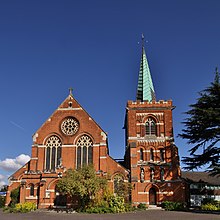George Fellowes Prynne
This article includes a list of references, related reading or external links, but its sources remain unclear because it lacks inline citations. (September 2021) |




George Halford Fellowes Prynne (1853–1927) was a leading Victorian and Edwardian English church architect. Part of the High Church school of Gothic Revival Architecture, Prynne's extensive work can be found across the south of England.[1]
Biography[]
Early life[]
George Halford Fellowes Prynne was born on 2 April 1853 at Wyndham Square, Plymouth, Devon. He was the second son of the Rev. George Rundle Prynne and Emily Fellowes (daughter of Admiral Sir Thomas Fellowes KCB DCL).[2] His elder brother was the painter Edward Arthur Fellowes Prynne. George Fellowes Prynne studied at St Mary’s College, Harlow. He went on to Chardstock College, and thence to Eastman’s Royal Naval Academy at Southsea.[2]
Career[]
In 1871, aged 18, Prynne he sailed America to work with a cousin who had taken land, and was farming in the Western states of America. But finding the work "trying and severe", after almost two years he travelled to Toronto was appointed to the role of Junior Assistant in the office architect Richard Cunningham Windyer.[3][4]
Four years later, Prynne had gained a senior position in the office, and offer of employment from the architect George Edmund Street.[5]He was employed by Street for a year, later working with architects Swinfern Harris, R.J. Withers, Alfred Waterhouse, and at the London School Board offices. He was a student at the Royal Academy between 1876 and 78. He commenced independent practice in 1879. Prynne became Architect to the Diocese of Oxford from 1913.[6]
Prynne designed many parish churches in England, mostly in the southeast and southwest, and almost always on a grand scale of high church Gothic Revival architecture. He also undertook significant restoration work, and in all is said to have been designed or restored over 200 buildings. Prominent examples include All Saints Church, West Dulwich[7] and St Peter’s, Budleigh Salterton.[8]
Prynne collaborated extensively with his brother Edward Arthur Fellowes Prynne who provided artwork for a number of the architect's churches. This includes St Peter’s Church Staines, which possesses Edward Arthur Fellowes Prynne windows of remarkable quality and beauty.[9] Other examples include altar panels at Holy Trinity, Roehampton, and St Mary, East Grinstead, and a reredos at St Mary the Virgin Church, Hayes.[10]
Family & personal life[]
George Fellowes Prynne married Bertha Geraldine Bradbury in June 1882 in Wandsworth, London. Prynne was a profoundly religious man with Anglo-Catholic convictions, and family prayers were said daily for the whole household. George and Geraldine Prynne latterly lived at number 3 Grange Road, Ealing.[2] He designed St Saviour's Church, Ealing nearby on Grove Road, Ealing (consecrated in 1899), and was heavily involved in the life of its Parish.[11] St Saviour's was demolished in 1940 following bomb damage, although the Clergy House designed by Prynne survives.[12] Prynne also designed an extension to Ealing Town Hall, including a new octagonally towered entrance, built in 1930.[13]
Prynne and his wife had seven children, five boys and two girls. Four of his five sons were in active service: Aubrey was blown over by a shell and his heart was displaced, and Harold was invalided out of the Army with severe dysentery. Both recovered, but Aubrey never regained good health. Both Edgar[14] and Norman[15]Fellowes Prynne were killed in active service, which had a profound effect on Prynne's later years.[16]
Non-referenced further reading[]
- Sharville, Ruth. "George Fellowes Prynne a brief biography". Ruth Sharville.
References[]
- ^ Sharville, Ruth (June 2012). "George Fellowes Prynne (1853-1927): a dedicated life" (PDF). Ecclesiology Today. 41 (SEVEN CHURCH ARCHITECTS 1830 – 1930): 120. Retrieved 7 November 2021.
- ^ a b c Felstead, Alison; Girouard, Mark; Franklin, Jonathan (2001). Directory of British Architects, 1834-1914. Bloomsbury Academic. ISBN 9780826455147. Retrieved 11 September 2021.
- ^ Sharville, Ruth (June 2012). "George Fellowes Prynne (1853-1927): a dedicated life" (PDF). Ecclesiology Today. 41 (SEVEN CHURCH ARCHITECTS 1830 – 1930): 107–8. Retrieved 7 November 2021.
- ^ Curl, James Stevens; Wilson, Susan (26 Feb 2015). The Oxford Dictionary of Architecture. Oxford. ISBN 9780191918742.
- ^ Sharville, Ruth (June 2012). "George Fellowes Prynne (1853-1927): a dedicated life" (PDF). Ecclesiology Today. 41 (SEVEN CHURCH ARCHITECTS 1830 – 1930): 107–8. Retrieved 7 November 2021.
- ^ Curl, James Stevens; Wilson, Susan (26 Feb 2015). The Oxford Dictionary of Architecture. Oxford. ISBN 9780191918742.
- ^ "CHURCH OF ALL SAINTS". Historic England. Retrieved 8 November 2021.
- ^ "CHURCH OF ST PETER". Historic England. Retrieved 8 November 2021.
- ^ St Peter's Church, Staines Parish: A Guide to the Stained Glass Windows. St Peter's Church, Staines.
- ^ Sharville, Ruth (June 2012). "George Fellowes Prynne (1853-1927): a dedicated life" (PDF). Ecclesiology Today. 41 (SEVEN CHURCH ARCHITECTS 1830 – 1930): 117–0. Retrieved 7 November 2021.
- ^ Sharville, Ruth (June 2012). "George Fellowes Prynne (1853-1927): a dedicated life" (PDF). Ecclesiology Today. 41 (SEVEN CHURCH ARCHITECTS 1830 – 1930): 106 & 118. Retrieved 7 November 2021.
- ^ "Clergy House, St Saviour's". Historic England. Historic England. Retrieved 8 November 2021.
- ^ Oates, Jonathan (2019). Ealing in 50 Buildings. Amberley Books. ISBN 1445687070.
- ^ "CAPTAIN EDGAR GEORGE FELLOWES PRYNNE". Commonwealth War Graves. Commonwealth War Graves Foundation. Retrieved 8 November 2021.
- ^ "Norman Fellowes Prynne". Everyone Remembered. Royal British Legion. Retrieved 8 November 2021.
- ^ Sharville, Ruth (June 2012). "George Fellowes Prynne (1853-1927): a dedicated life" (PDF). Ecclesiology Today. 41 (SEVEN CHURCH ARCHITECTS 1830 – 1930): 106 & 118. Retrieved 7 November 2021.
- 1853 births
- 1927 deaths
- Architects from Devon
- Gothic Revival architects
- People from Plymouth
- People educated at Eastman's Royal Naval Academy